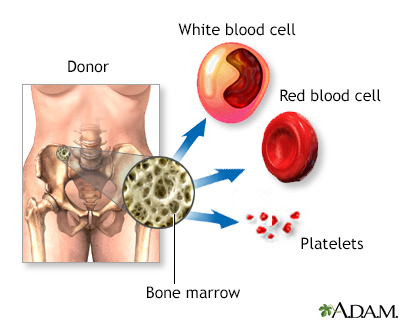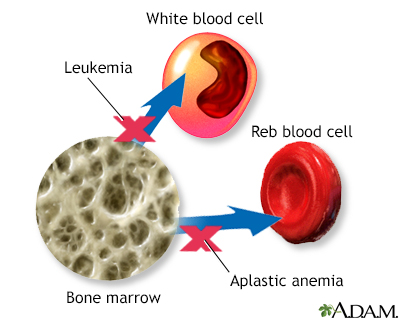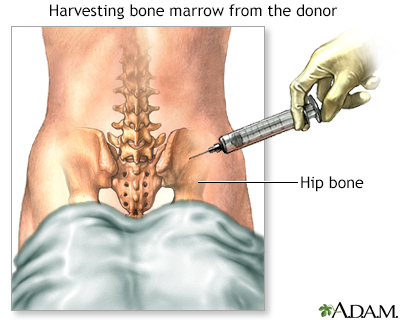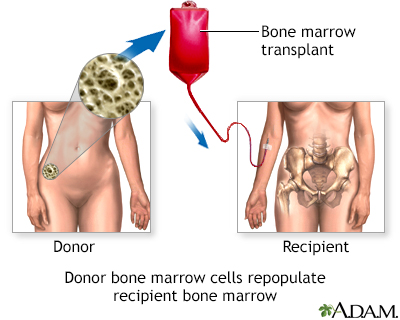Bone-marrow transplant - series

Normal anatomy
Bone-marrow is a soft, fatty tissue found inside of bones that produces blood cells (red blood cells, white blood cells, and platelets). Red blood cells carry oxygen throughout the body. White blood cells act to ward off infection. Platelets aid in blood-clotting.

Indications
Bone-marrow transplants are performed for:
- Deficiencies in red blood cells (aplastic anemia) and white blood cells (leukemia or lymphoma)
- Aggressive cancer treatments (chemotherapy or radiation therapy)
- Inherited (genetic) diseases (such as thalassemia)
- Immune-system disorders (such as congenital neutropenia and severe-combined immunodeficiency syndrome)

Procedure
While you are awake and pain-free (using local anesthesia), bone marrow is removed from the top of the hip bone (iliac crest). The bone marrow is filtered, treated, and transplanted immediately. Other times it's frozen and stored for later use. The bone marrow is then transfused through a vein (IV line). It naturally transports itself back into the intended bone cavities, where it grows quickly to replace the old bone marrow.

Aftercare
Bone-marrow transplants prolong the life of patients who might otherwise die. As with all major organ transplants, however, it is difficult to find bone-marrow donors, and the cost of surgery is very high. The donor is usually a sibling with compatible tissue. The more siblings you have, the better the chance of finding the right match. Occasionally, unrelated donors act as a source for bone-marrow transplants. The hospitalization period is three to six weeks. During this time, you are isolated and under strict monitoring because of the increased risk of infection. Attentive follow-up care is required for two to three months after discharge from the hospital. It takes about six months to a year for the immune system to fully recover from this procedure. Relatively normal activities are resumed after consulting with your doctor.
BACK TO TOP
Review Date: 2/3/2025
Reviewed By: Warren Brenner, MD, Oncologist, Lynn Cancer Institute, Boca Raton, FL. Review provided by VeriMed Healthcare Network. Also reviewed by David C. Dugdale, MD, Medical Director, Brenda Conaway, Editorial Director, and the A.D.A.M. Editorial team.

Health Content Provider
06/01/2025
|
A.D.A.M., Inc. is accredited by URAC, for Health Content Provider (www.urac.org). URAC's accreditation program is an independent audit to verify that A.D.A.M. follows rigorous standards of quality and accountability. A.D.A.M. is among the first to achieve this important distinction for online health information and services. Learn more about A.D.A.M.'s editorial policy, editorial process and privacy policy. A.D.A.M. is also a founding member of Hi-Ethics. This site complied with the HONcode standard for trustworthy health information from 1995 to 2022, after which HON (Health On the Net, a not-for-profit organization that promoted transparent and reliable health information online) was discontinued. |
The information provided herein should not be used during any medical emergency or for the diagnosis or treatment of any medical condition. A licensed medical professional should be consulted for diagnosis and treatment of any and all medical conditions. Links to other sites are provided for information only -- they do not constitute endorsements of those other sites. © 1997- 2025 A.D.A.M., a business unit of Ebix, Inc. Any duplication or distribution of the information contained herein is strictly prohibited.
